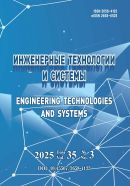UDC 617-089
DOI: 10.15507/0236-2910.027.201703.410-427
Pathogenetical grounds for effectiveness of mini-invasive interventions in emergency surgery
Aleksey P. Vlasov
Head of the Faculty Surgery Chair, Medical Institute, National Research Mordovia State University (68, Bolshevistskaya St., Saransk 430005, Russia), Dr.Sci. (Medicine), professor, ORCID: http://orcid.org/0000-0003-4731-2952, This email address is being protected from spambots. You need JavaScript enabled to view it.
Viktor A. Bolotskikh
Associated Professor of the Operative Surgery and Topographic Anatomy, Burdenko Voronezh State Medical Academy (10 Studencheskaya St, Voronez 394000, Russia), Ph.D. (Medicine), ORCID: http://orcid.org/0000-0001-6097-6361, This email address is being protected from spambots. You need JavaScript enabled to view it.
Eriken K. Salakhov
Head of Surgical Department of Mendeleevsk Central Regional Hospital (7, Severnaya St., Mendeleyevsk 423650, Russia), Ph.D. (Medicine), ORCID: http://orcid.org/0000-0003-2119-8020, This email address is being protected from spambots. You need JavaScript enabled to view it.
Pavel A. Vlasov
Associated Professor of the Faculty Surgery Chair, Medical Institute, National Research Mordovia State University (68, Bolshevistskaya St., Saransk 430005, Russia), Ph.D. (Medicine), ORCID: http://orcid.org/0000-0002-4389-3449, This email address is being protected from spambots. You need JavaScript enabled to view it.
Nikita S. Sheyranov
Ph.D. Candidate of the Faculty Surgery Chair, Medical Institute, National Research Mordovia State University (68, Bolshevistskaya St., Saransk 430005, Russia),ORCID: http://orcid.org/0000-0001-8153-1660, This email address is being protected from spambots. You need JavaScript enabled to view it.
Pavel P. Zaytsev
Dr.Sci. Candidate of the Faculty Surgery Chair, Medical Institute, National Research Mordovia State University (68, Bolshevistskaya St., Saransk 430005, Russia), Ph.D. (Medicine), ORCID: http://orcid.org/0000-0002-6564-2325, This email address is being protected from spambots. You need JavaScript enabled to view it.
Tatyana I. Vlasova
Associated Professor of the Normal and Pathological Physiology Chair, Medical Institute, National Research Mordovia State University (68, Bolshevistskaya St., Saransk 430005, Russia), Dr.Sci. (Medicine),ORCID: http://orcid.org/0000-0002-2624-6450, This email address is being protected from spambots. You need JavaScript enabled to view it.
Svetlana V. Abramova
Head of the Obstetrics and Gynecology Chair, Medical Institute, National Research Mordovia State University (68, Bolshevistskaya St., Saransk 430005, Russia), Ph.D. (Medicine), docent, ORCID: http://orcid.org/0000-0003-1922-5771, This email address is being protected from spambots. You need JavaScript enabled to view it.
Introduction: The article deals with manifestations of the metabolic response to surgical treatment of acute destructive cholecystitis and peritonitis with various traumatization of the abdominal wall (“open” laparotomy wound or minimally invasive approach).
Materials and Methods: The clinico-laboratory analysis of patients with acute cholecystitis volume and acute peritonitis was performed. All patients were operated with the necessary surgical intervention. The patients in the control groups were operated with a laparatomic operative approach, in the main groups, mini-invasive laparoscopic technology was used. The examination of patients of both groups was performed at admission and in the dynamics of the postoperative period (1st , 2nd , 4th , 6th day after the operation). In addition to routine biochemical blood tests in the patients, the intensity of endotoxemia (the plasma level was determined by the molecules of medium mass, total and effective albumin concentration), the peroxide oxidation of membrane lipids and the activity of superoxide dismutase and phospholipase A2 were assessed.
Results: The decrease in the albumin toxicity index was observed with respect to control (in cholecystitis – by 25.1–37.7 % (p < 0.05), in acute peritonitis – by 25.5–39.3 % (p < 0,05), a decrease in the hydrophilic component of endotoxicosis was also recorded (for peritonitis – by 12.7 – 37.8 % (p < 0.05), with cholecystitis – 14,4–36,4 % (p < 0.05) in the early postoperative period. The index of TBA-active products in patients of the main group with cholecystitis was below the control by 16.2–27.9% (p < 0.05), with peritonitis – by 19.3–33.5% (p < 0.05).
Discussion and Conclusions: In the early postoperative period the much less homeostatic disorders are noted when using minimally invasive interventions, regardless of the pathology. In particular, it is the comparatively low endotoxemia, manifested by a decrease in the accumulation of biologically active toxic components. The advantage of low-traumatic operations is also in the relatively low intensity of the process of peroxide oxidation of membrane lipids and a decrease in the activity of phospholipases in the early postoperative period.
Keywords: surgical trauma, minimally invasive surgical technologies, endogenous intoxication, membrane-destructive process, cholecystitis, peritonitis
For citation: Vlasov A. P., Bolotskikh V. A., Salakhov E. K., Vlasov P. A., Sheyranov N. S., Zaytsev P.P., Vlasova T. I., Abramova S. V. Pathogenetical grounds for effectiveness of miniinvasive interventions in emergency surgery. Vestnik Mordovskogo universiteta = Mordovia University Bulletin. 2017; 27(3):410–427. DOI: 10.15507/0236-2910.027.201703.410-427
Contribution of the co-authors: A. P. Vlasov: collection and analysis of clinical data, writing the draft; V. A. Bolotskikh: collection of laboratory data, analysis of the results obtained, writing the article; E. K. Salakhov: collection; of clinical data, data processing; P. A. Vlasov: collection of clinical and laboratory data, writing the draft; N. S. Sheyranov: collection of clinical and laboratory data, data analysis; P. P. Zaytsev: collection of clinical and laboratory data, analysis of the results obtained, writing the draft; T. I. Vlasova: statistical processing and analysis of clinical and laboratory data, writing the draft; S. V. Abramova: statistical processing and analysis of clinical and laboratory data.

This work is licensed under a Creative Commons Attribution 4.0 License.

















